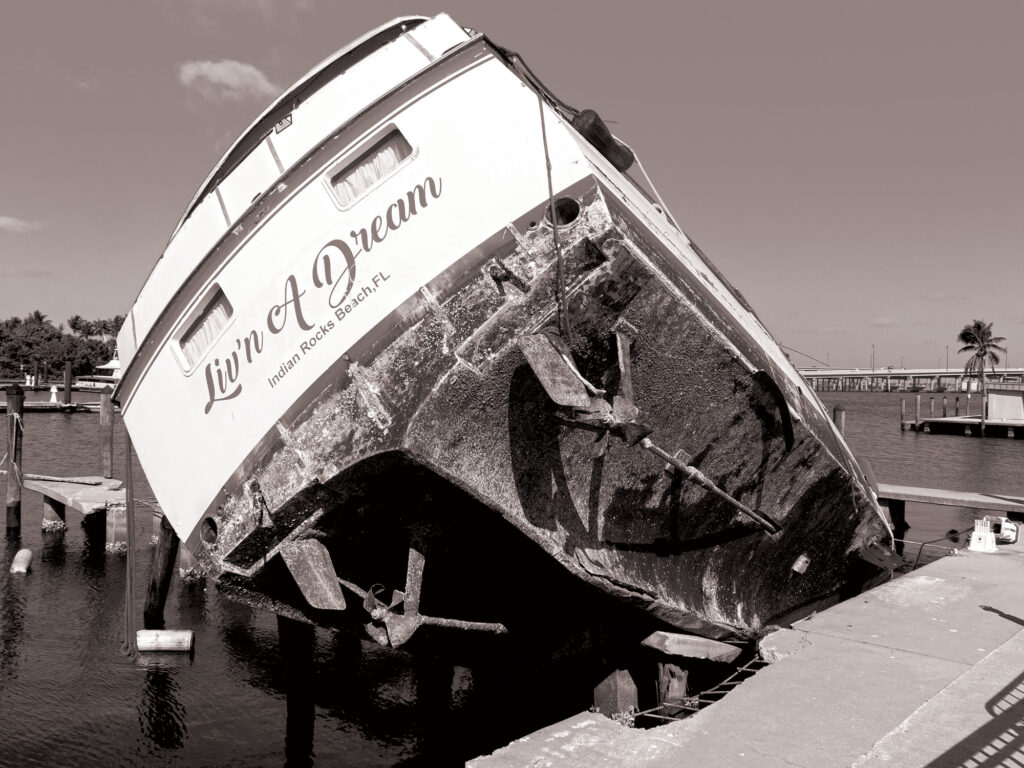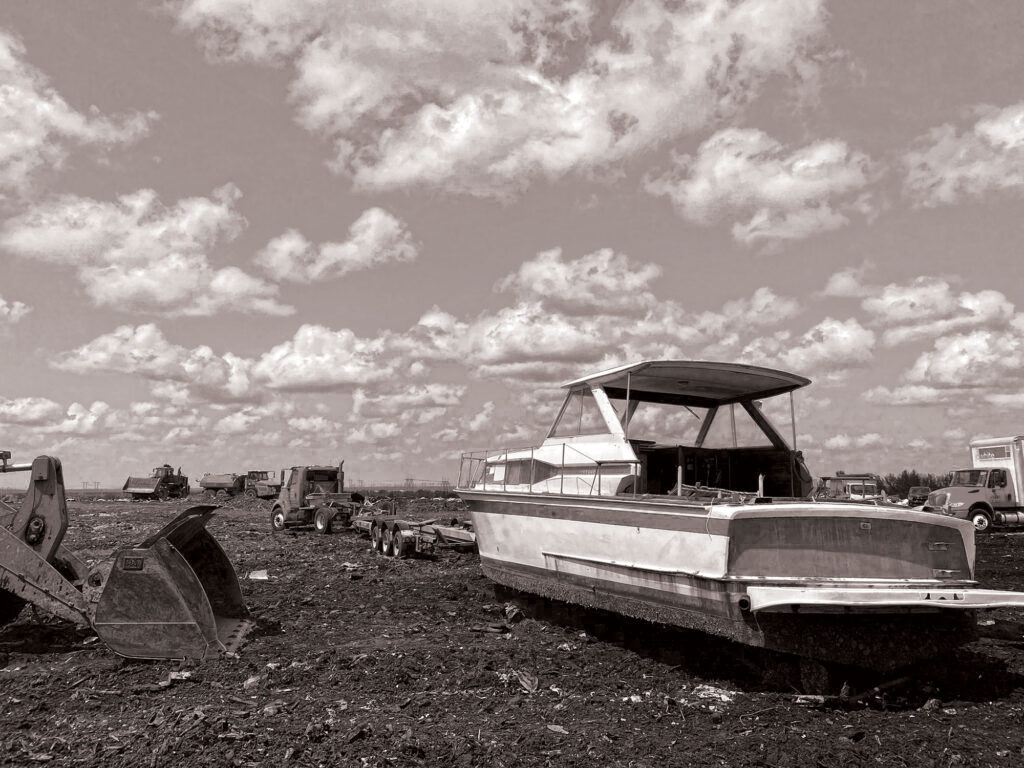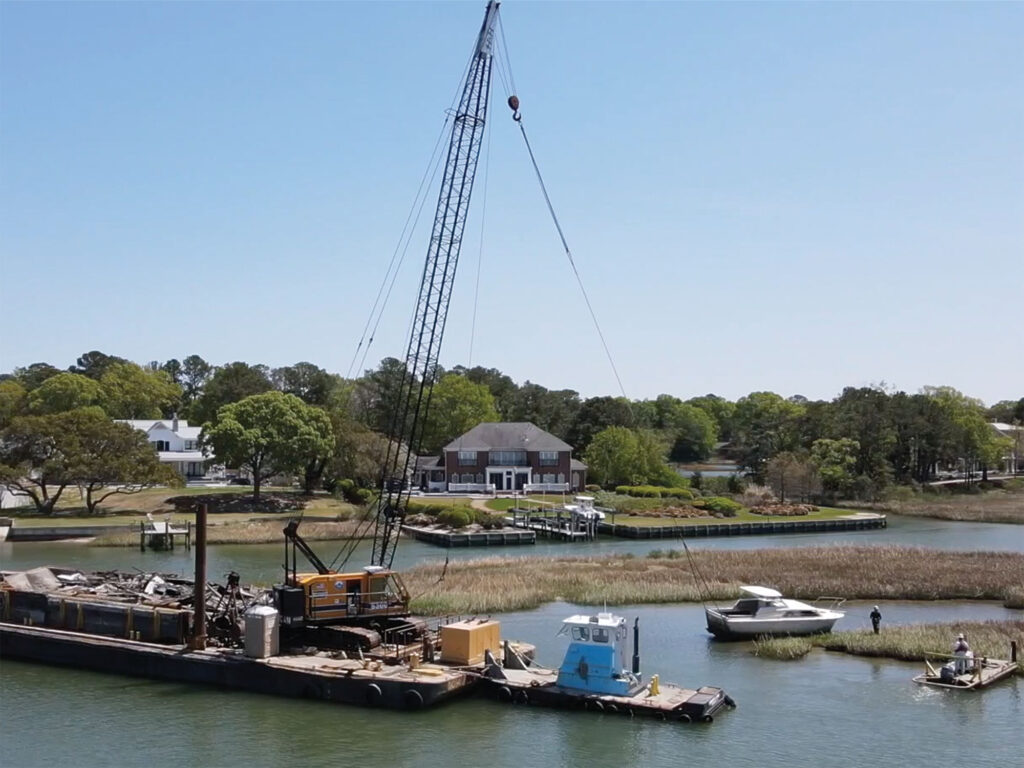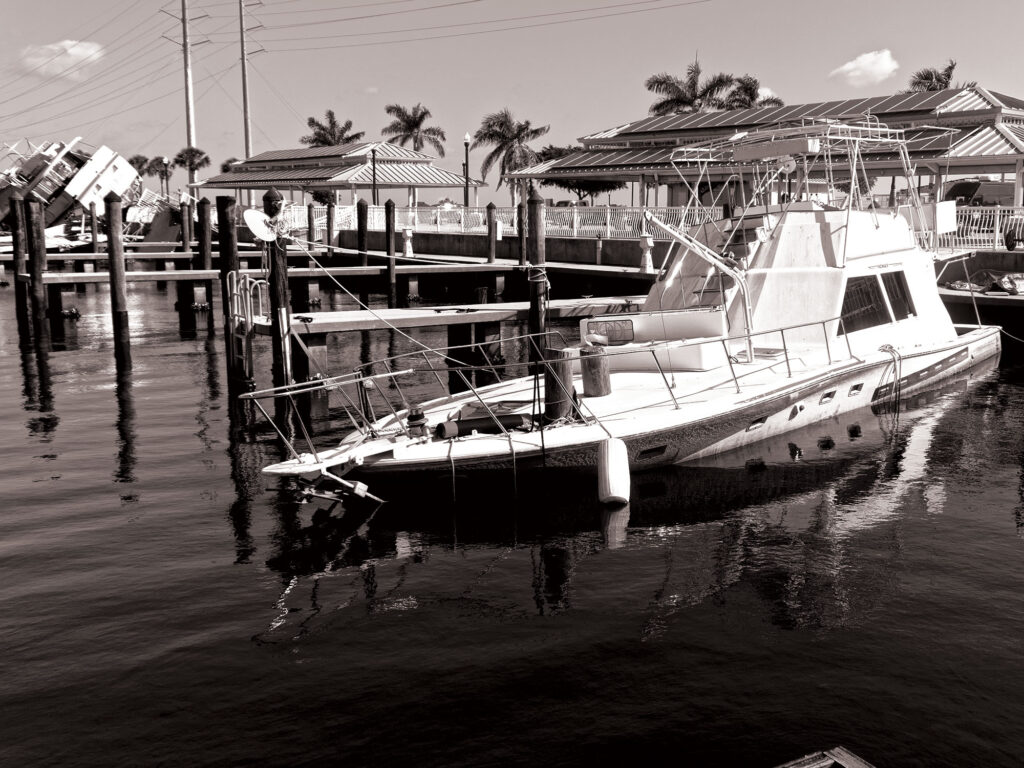What Happens to Abandoned Boats?
 Damaged boats are just one of many hazards left behind after storms.
Randy Vance
Damaged boats are just one of many hazards left behind after storms.
Randy Vance
Mike Provost was boating with his family one day when they saw a disintegrating boat tied up to a tree on the shore of Long Creek, one of the hundreds of creeks threading through the Virginia Beach area and feeding into Chesapeake Bay. Long Creek is part of a waterway in which Provost frequently boats with his wife, Ashley, and their kids.
The 30-foot cabin cruiser looked abandoned. It was floating, but weeds were growing through the hull, and debris and broken boat components littered its decks.
“We’re going by this suspicious craft, and my kids asked what was going on with that boat,” Provost explains. “I said, ‘Well, I think somebody just left it there.’ They asked, ‘Well, Daddy, who’s going to clean it up?’ I said, ‘I will.’
“That was a mistake.”
Provost thought his job was finished when he called local authorities for assistance. But several trips later, the family saw the cabin cruiser still in the water.
One day, Provost noticed that the boat had been relocated into the North Landing River, lodging onshore of First Landing State Park. “Truly a national treasure, it’s the most visited state park in Virginia,” he says. “It’s a place we like to hike and spend time outdoors as a family. That’s when I kind of got obsessed.”
Provost is a retired US Navy Special Warfare Combatant-Craft Crewman chief warrant officer. Over 21 years in the military, he spent 52 months abroad in 26 countries. He also holds a USCG 100-Ton Master Captain’s License. In short, he’s not someone who gives up easily. He called 100 different people in 30 different state, federal and nonprofit offices, trying to find some entity that would agree to clean up the boat since the owner wouldn’t.
“I was just relentless. I called every single person I could think of, and when they said they couldn’t help me, they gave me a lead,” Provost explains. “Frankly, I annoyed a lot of people, but I was just
unwilling to let this boat sit there because it was, in my opinion, a clear difference of right and wrong.”
Finally, Provost took matters into his own hands. Following a list of procedures outlined by the Virginia Department of Wildlife Resources, he gained the owner’s permission to remove the boat.
“And we were off to the races,” he explains. “We established a GoFundMe campaign. We had a very generous corporate sponsor jump in, then a private donor did a bulk of the payment. Then we got to work.”
Provost and his fellow volunteers dismantled and removed the boat in two days. And so Provost’s nonprofit, the Vessel Disposal and Reuse Foundation, was born.
 A growing number of states have created or are piloting programs to prevent abandoned boats.
Courtesy TowBoatUS Ft. Lauderdale
A growing number of states have created or are piloting programs to prevent abandoned boats.
Courtesy TowBoatUS Ft. Lauderdale
Since its formation in December 2021, the foundation has disposed of 77 vessels, removed more than 718,000 pounds of debris from Virginia waterways, and recycled more than 27,000 pounds of metal. Provost has his sights set on 11 more vessels, but he needs the funding to proceed.
According to Virginia law, it’s illegal for owners to abandon their boats. In 2022, the Virginia Marine Resources Commission received $3 million from the Virginia General Assembly to create the Abandoned or Derelict Vessel Program, aimed at removing abandoned and derelict boats from tidal or nontidal marine waters of the state. Grants through the program are available to local governments and municipalities for boat removal.
The problem, unfortunately, is not unique to the Chesapeake. Derelict vessels litter popular waterways from coast to coast. Each one is not just an eyesore or an environmental concern, but it’s also a potential hazard to other boaters. Here’s how others besides Provost are taking action.
 Removing abandoned boats can require some heavy machinery.
Courtesy VDRF Project
A Nationwide Problem
Removing abandoned boats can require some heavy machinery.
Courtesy VDRF Project
A Nationwide Problem
During the 1960s and ’70s, fiberglass boats exploded in popularity. But fiberglass boats, unlike cars or boats made of aluminum or other metals, can’t be scrapped. The fiberglass is not always recyclable, and the cost of disposing of the boats can be steep.
The BoatUS Foundation is the nonprofit arm of BoatUS, the country’s largest organization of recreational boat owners. It recently won a $10 million grant through the National Oceanic and Atmospheric Administration as part of the Bipartisan Infrastructure Law and Inflation Reduction Act to tackle the issue of abandoned and derelict vessels, or ADVs.
“When you buy a boat, the last thing you think about is getting rid of it,” says Alanna Keating, director of outreach for the BoatUS Foundation. “I had a 1986 Volvo in my 20s. Somebody wanted it, and they paid me to take it away. Somebody will always take your car for free or give you money. It’s not the same with a boat. There are no sustainable disposal options for boats.”
Keating estimates the average cost to dispose of a nonoperating—but still floating—25- to 30-foot boat is anywhere from $5,000 to $25,000. Depending on location, availability of services and the condition of the boat, disposal can cost several thousand dollars, she said—even if the boat is on a trailer. It’s just easier for people to abandon boats or sell them for pennies on the dollar.
The grant will help the BoatUS foundation issue awards to communities and organizations to remove ADVs from local waterways. The foundation is also working with state governments, local organizations and the boating public to build a national database to identify abandoned vessels for removal. A third part of the grant funded a conference, called Turning the Tide, that BoatUS hosted this past February. The conference brought industry experts and academics together to discuss end-of-life options for boats, including addressing challenges for recycling fiberglass boats.
Keating says that inland areas can pose a particular challenge for ADV removals. “There’s never been funding on a federal level for inland areas, and most of the time, I don’t think they even know the scope of the problem because the programs aren’t there for them to address it.”
The BoatUS Foundation plans to use the bulk of its grant to help with these types of removals. The foundation began to award the first wave of grantees this past spring. Awardees and all grant applicants also were invited to the February conference in order to learn about disposal options as well.
Keating developed the national ADV database in partnership with state agencies based on a survey of the public and partner organizations working in ADV removal. The database was on track to be available online by this summer so that the boating public might also help in tracking the issue.
“The big question is: How many ADVs are out there? The answer is: Nobody knows,” Keating points out. “We are uniquely positioned to have that strong connection with BoatUS and the over 700,000 BoatUS members who are on the water all the time who can tell us about those ADVs.”
 Removing a disintegrating boat from a waterway is an expensive task.
Randy Vance
State of Urgency
Removing a disintegrating boat from a waterway is an expensive task.
Randy Vance
State of Urgency
Trashing a boat is expensive. Removing a disintegrating boat from a waterway is vastly more expensive—notwithstanding the additional environmental cost of abandoned boats.
Troy Wood is the program manager for the Derelict Vessel Removal Program, part of Washington’s Department of Natural Resources. He points out the environmental impact of abandoned boats.
“Other than the obvious things like fuel and oil that spill out of vessels, there’s a lot of hidden stuff in these vessels that pose a risk to human safety in the environment such as asbestos,” Wood says. “Copper bottom paints shed into the environment. There have been studies that have found contaminants in orcas that were directly related to possibly derelict and abandoned vessels.”
Washington initiated its program in 2002, and since then has removed more than 1,500 vessels from 2.6 million acres of state-owned aquatic lands. The state funds its program through a tax on the registration of vessels as well as a portion of sales tax on sold marine products.
The program also won funding through NOAA’s Marine Debris Program to both help remove vessels from marine waters and establish a vessel turn-in program. With the money, Wood and his team of six employees coordinated the removal of seven vessels from South Puget Sound and sponsored six vessel turn-in events. The last event accepted about 30 vessels from the Swinomish Tribe in Skagit County.
The state prioritizes removal based on the boat’s threat to human safety and the environment. To take custody of the vessel for removal, the state has to make contact with the owner to give them the opportunity to remove it themselves. The boats can languish for as little as a week or for a few years, Wood says, depending on the human and environmental risk. There are currently about 300 identified abandoned vessels in the state.
Once the boats are recovered, Wood has to grapple with what to do with the removed and surrendered boats.
“Obviously, we recycle the aluminum and steel vessels, but our problem is the wooden and fiberglass vessels. How do we recycle that? Because we don’t want to take the trash out of the water and just stick it on land,” Wood points out.
The state found a facility that accepts the crushed boats and recycles what they can. What they can’t, they sell as “hog fuel” to factories that manufacture concrete or paper.
“There was a study done in Rhode Island a few years ago where they burned fiberglass vessels instead of what they normally burned to produce concrete, and it lowered their emissions,” Wood reveals. “You still get emissions from burning fiberglass vessels, but it’s not as bad as their normal fuel.”
The Washington program is making good headway. Prior to the watercraft excise tax, the program’s budget was about $2 million every two years. Now, the tax funnels about an extra $8 million into the program every two years.
“We quadrupled our budget, and we more than quadrupled the amount of vessels we were pulling out,” Wood says. Over the 2022 and 2023 fiscal years, the program removed 319 vessels from state waterways.
In addition to the removal program, Washington also has a vessel turn-in program, which Wood hopes boaters will use, to prevent boats from becoming abandoned in the first place.
 It can take years to remove some boats, depending on the human and environmental risk.
Courtesy Rick Legow
The Florida Program
It can take years to remove some boats, depending on the human and environmental risk.
Courtesy Rick Legow
The Florida Program
Phil Horning, administrator of Florida’s Derelict Vessel Program, has a map of Florida peppered with dots. Each dot represents an abandoned boat that the state is actively working to remove.
“If you took the map away, the vessels, which are the dots on the map, would make a perfect outline of Florida,” Horning says. “They’re everywhere, and they’re mostly on the coast.”
Florida has a little more than 1.2 million registered boaters. For how many boaters the state has, the rate of abandoned boats—though a serious problem—is pretty low.
People who abandon boats in Florida receive a misdemeanor citation. In each case, the derelict boat has to be investigated by a sworn law enforcement officer, and then the misdemeanor charge has to wind its way through the court system. The owners, if known, receive an opportunity for a civil hearing on vessel removal.
“Ultimately, the vessel owner is responsible for their vessel, and at the end of life, they should be taking this thing off the water and disposing of it,” Horning believes. “But what happens in many cases is that they sell it to somebody for a dollar, and those people don’t have the means to take care of it, and it ends up becoming a $12,000 removal.”
Ultimately, Florida may have found a solution: the Florida Vessel Turn-In Program. The state established the program in September 2022—just in time for Hurricane Ian to hit. The program began shifting into gear in March 2023. Since then, boaters whose watercraft meet a certain set of criteria have turned in 155 vessels, which have been removed and disposed of. Twenty-seven are on schedule for removal, and 19 are currently in review.
Both programs are under Florida’s Fish and Wildlife Conservation Commission, and are currently funded through the state. The vessel turn-in program is completely voluntary, and typically the boat owners are self-reporting, according to Horning.
“It’s a win-win situation,” he says. “We get a potential derelict vessel off the water before it goes derelict. The owner doesn’t have a criminal penalty imposed against them, and they aren’t charged for disposal. They can get rid of this thing before it becomes their nightmare.”
Read Next: Avoiding Post-Storm Hazards
 Protecting waterways from hazardous fluid leaks is an important part of the process.
Courtesy VDRF Project
Cleaning Up
Protecting waterways from hazardous fluid leaks is an important part of the process.
Courtesy VDRF Project
Cleaning Up
Abandoned vessels are a problem, but a growing number of states have created or are piloting programs to prevent them. Florida modeled its program after similar ones in California, Oregon, Texas and Washington. In 2024, South Carolina piloted a turn-in program, funded by NOAA, for people and businesses in the state’s eight coastal counties.
In Virginia, Provost hopes to add a vessel turn-in program to his nonprofit. Preferring to work through corporate and private sponsors, he just needs funding.
“The way that we solve this is to treat the root cause,” Provost explains. “There’s no easy and affordable way to get rid of an unwanted vessel.
“So we need to get these vessels while they’re at risk of becoming abandoned and derelict,” he adds. “And frankly, nobody’s doing it, so somebody has to.”
Turn It InWith all the problems caused by abandoned boats, the best solution seems to be to make it easier for owners to turn in their old vessels before they become a risk. If you have an old vessel that you can no longer maintain or operate, here is a list of just a few programs that you can contact for help.
- Florida Vessel Turn-In Program (VTIP)
- Rhode Island Fiberglass Vessel Recycling Program
- California Surrendered and Abandoned Vessel Exchange
- Washington (State) Vessel Turn-In Program
- Oregon Abandoned and Derelict Vessel Program
- South Carolina Vessel Turn-In Programs (run on a sporadic basis, check for opportunities)
For nationwide information on abandoned and derelict vessel programs, visit marinedebris.noaa.gov/resources/abandoned-and-derelict-vessels-info-hub.
The post What Happens to Abandoned Boats? appeared first on Boating Mag.
- Home
- About Us
- Write For Us / Submit Content
- Advertising And Affiliates
- Feeds And Syndication
- Contact Us
- Login
- Privacy
All Rights Reserved. Copyright , Central Coast Communications, Inc.